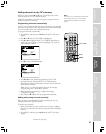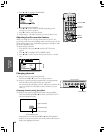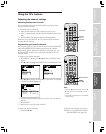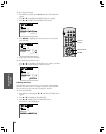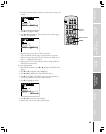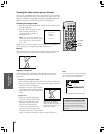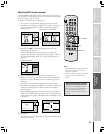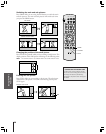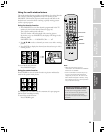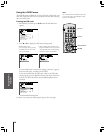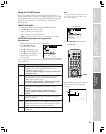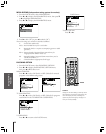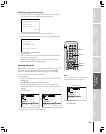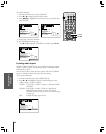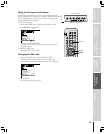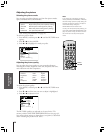
Introduction
Connecting
your TV
Using the
Remote Control
Setting up
your TV
Using the TV’s
Features
Appendix
Index
29
123
456
789
ENT
100
0
CH
VOL
POWER
TIMER
RECALL
TV/VIDEO
MUTE
TV
CABLE
VCR
CH RTN
PIC SIZE
EXIT
LIGHT
STOP SOURCE
ADV/
PIP CH
ADV/
PIP CH
FAV
FAV
PLAY PIP
REC TV/VCR REW FF
STILL LOCATE SWAP
FAVORITE
MENU/
STROBE
ENTER
Note:
•When the main picture source is
“colorstream”, the FAVORITE and STROBE
buttons are not available.
• If the V-CHIP feature is active and you try
to scan a TV program that exceeds the
rating limits you set, the “ X” mark on the
black window will appear. However, during
the scanning period, the V-CHIP operation
may not be done correctly.
STROBE
FAVORITE
ENTER
yzx •
Using the multi-window feature
The multi-window feature provides two functions. One is the Favorite
that scans the channels programmed in the TV memory by the
FAVORITE CH function (9-picture multi-search) and other is the
Strobe that is convenient when watching a quickly moving picture
such as a sport program.
Using the favorite function
1. Press FAVORITE to scan the channels programmed in the TV
memory by the favorite channel function (page 23).
The 9-picture multi-search will start.
The first window will be displayed with a moving picture.
Each time yn ppr ess FAVORITE, the display will change in the
following order.
FAVORITE CH1—— FAVORITE CH2 —— off
2. Press y z x • to select a channel you want to see with a moving
picture.
3. Press ENTER to display the channel you selected at step 2 with a
normal picture.
6
7
7
9
X
12
18
42
97
106
33
To cancel the favorite function:
Press FAVORITE again.
Using the strobe function
Press STROBE to start the strobe function. 9-picture multi-strobe
starts for the present main picture.
For example, you can watch a decisive moment of a sport program
that has been recorded previously.
To cancel the strobe function:
Press STROBE again.
NOTICE OF POSSIBLE ADVERSE
EFFECTS ON TV PICTURE TUBE
If a fixed (non-moving) pattern remains
on the TV screen for long periods of time,
the image can become permanently
engrained in the picture tube. See page 2
for details.



